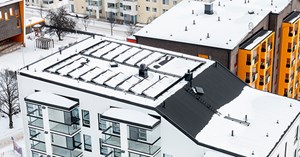Nationally affordable electricity distribution in the Oulu region
Oulun Energia Sähköverkko is now even more affordable for its customers. Network service prices trigger heated debate from time to time – the charge is based on an extensive service, the maintenance and operational capability of which is the responsibility of the network operator.
From the beginning of April, Oulun Energia Sähköverkko customers can enjoy even more affordable distribution charges or network service prices. In Finland, the Energy Authority oversees the reasonableness of distribution charges. Energy Authority statistics show that Oulun Energia Sähköverkko’s new network service prices make the company among the ten most affordable network operators nationwide in an examination of the figures for small consumer user groups. All 77 Finnish network operators were included in the benchmarking.
The Energy Authority’s regulatory model determines the power distribution charge and depends on a number of individual factors such as the value of electricity network assets, security of supply and operating efficiency. When a network operator successfully keeps a rein on its own costs and outsourced services, the ensuing savings are reflected in a positive light in the consumer’s monthly bill. This is where Oulun Energia Sähköverkko has done some worthwhile work and where the efficiency of the electricity network also plays a key role.
“One of the factors driving the price cut is effective control of operating costs coupled with a systematic, long-term moderate investment programme,” says Anna Pasma, Managing Director of Oulun Energia Sähköverkko Oy.
Electricity network investments include building a completely new network and upgrading the old electricity network. Oulun Energia Sähköverkko has invested in underground cabling, which now accounts for as much as 88% of the entire electricity network. Underground cabling is more reliable than aerial cables and maintenance and repair work is less costly.
“Extensive underground cabling makes sense in an urban environment, where there is also a high population density. This means the network length per customer is shorter than in rural areas and in turn means lower distribution prices for customers,” Pasma explains.
How much does electricity distribution really cost?
When a customer receives a combined bill from the electricity seller and network operator, the sum total consists of the electricity energy, i.e. the electricity consumed, and the network service (electricity distribution) price. The network service price depends on statutory taxes, which can account for as much as half of the distribution bill. The basic network service charge and distribution charge again include the cost of building, maintaining and operating the electricity network, in other words everything needed to provide the electricity network service.
“As much as 90% of electricity network costs are fixed costs. A network operator’s greatest asset is its service platform, in other words the electricity network, the maintenance of which generates costs. The network needs to have been built and ready to operate even though electricity is not used every minute of the day,” Anna Pasma illustrates.
The real costs of the electricity network are determined based on the need for capacity, not on how much electricity is used. This explains why, for example, although electricity consumption at a holiday home is low, the network operator invests heavily in ensuring an electricity supply there, too.
“This means that in a way, the customer pays for making electricity available at all times,” Pasma explains.
Maintenance personnel need to be on call 24/7 or every hour of the day throughout the year to ensure a fully functioning electricity network. Faults are unpredictable and any alarm detected requires an immediate response so that the fault can be repaired as quickly as possible. Preventive maintenance of the distribution network includes regular inspections and servicing, which also involves photographing power lines and clearing routes in the vicinity of power lines in woodland areas.
Maintenance of the existing electricity network also requires many other personnel who are responsible for providing a smooth service to meet customer needs.
“Network operators also have an obligation to meter actual electricity consumption, which in practice means reading electricity meters. Meter reading data is recorded in the metering data system and customer data system. The data determines how much the customer’s electricity bill is. A network operator also incurs costs from providing customer service, technical advice and other daily services,” Anna Pasma lists.



